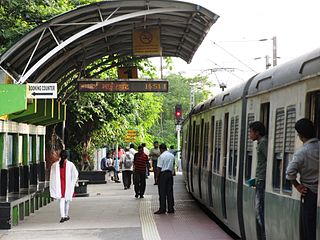
Transport in India consists of transport by land, water and air. Road transport is the primary mode of transport for most Indian citizens, and India's road transport systems are among the most heavily used in the world.
Rail transport in India is an important mode of conveyance for people and goods in India. Indian Railways (IR) is the primary operator of rail operations throughout the country. IR is a state-owned organisation of the Ministry of Railways, which historically had its own government budget. Between 2019 and 2020, 22.15 million passengers used the Indian Railways network daily. In the same period, 3.32 million metric tons of freight was also shipped daily on the IR network.

The Mumbai Metro is a rapid transit (MRT) system serving the city of Mumbai and the wider Mumbai Metropolitan Region in Maharashtra, India.

The Kolkata Metro is a rapid transit system serving the city of Kolkata and the wider Kolkata Metropolitan Region in West Bengal, India. It is the first operational rapid transit system in India, and the second busiest metro network in India. As of January 2023 it has three operational lines: a 31.36 km (19.49 mi) line from Dakshineswar to Kavi Subhash, a 9.1 km (5.7 mi) line from Salt Lake Sector V to Sealdah, and a 6.5 km (4.0 mi) line from Joka to Taratala, for a total of 46.96 km (29.18 mi). Three other lines are in various phases of construction. The system has a mix of underground, at-grade and elevated stations using both broad-gauge and standard-gauge tracks. Trains operate between 06:55 and 22:30 IST and the fares range from ₹5 to ₹25.

Namma Metro, also known as Bengaluru Metro, is a rapid transit system serving the city of Bengaluru, India. It is the second longest operational metro network in India with an operational length of 73.75 kilometers just after Delhi Metro. Upon its inauguration, it became the first underground metro system in South India. Namma Metro has a mix of underground, at grade, and elevated stations. Out of the operational 66 metro stations of Namma Metro as of October 2023, there are 57 elevated stations, 8 underground stations and 1 at-grade station. The system runs on standard-gauge tracks.

The Chennai Metro is a rapid transit system serving the city of Chennai, Tamil Nadu, India. It is the 4th longest metro system in India. The system commenced service in 2015 after partially opening the first phase of the project. The current network consists of two colour-coded lines covering a length of 54 kilometres (34 mi). The Chennai Metro Rail Limited (CMRL), a joint venture between Government of India and the Government of Tamil Nadu built and operates the Chennai Metro. The system has a mix of underground and elevated stations and uses standard gauge. The services operate daily between 05:00 and 23:00 with a varying frequency of 2 to 8 minutes.

The Kolkata Suburban Railway is a suburban rail system serving the Kolkata metropolitan area and its surroundings in India. It is the largest suburban railway network in the country by number of stations and track length, and also one of the largest in the world. There are five main lines and nineteen branch lines. It operates more than 1,500 services, carrying 3.5 million people daily and 1.2 billion people every year. It runs from 03:00 am until 02:00 am and fares range from Rs.5 to Rs.25. The system uses 25 kV 50 Hz AC power supply and runs on 5 ft 6 in broad gauge track. It has interchange stations with the Kolkata Metro at various locations.
The city of Nagpur is strategically located in central India. It has a vast railway network and its road network is well-maintained to avoid congestion. There are 4 modes of transportation in Nagpur. Nagpur is connected to India's four major metropolitan areas by road, rail and air. Auto rickshaws operate in most parts of the city, and are the main form of hired transport.

Bengaluru Suburban Railway is an under construction suburban rail network for the city of Bangalore. A Suburban Rail system for the city was first proposed in 1983. Since then, several different route proposals were made but no Suburban Rail project took shape. It was finally approved in the 2019 Railway Budget.

Lucknow Metro is a mass rapid transit (MRT) system in Lucknow, Uttar Pradesh, India. The metro is owned and operated by the Uttar Pradesh Metro Rail Corporation (UPMRC).

Urban rail transit in India plays an important role in intracity transportation in the major cities which are highly populated. It consists of rapid transit, suburban rail, monorail and tram systems. According to a report published in 2021, a total of 2.63 billion people travelled annually in metro systems across India's sixteen major cities, placing the country as one of the busiest urban rapid transit hubs in the world in terms of ridership. The combined length of 895 kilometres of metro systems in India makes it the third longest in operation in the world.

Kolkata Metro Rail Corporation (KMRC) is a Government of India enterprise formed in 2008. The agency was formed to oversee the implementing Kolkata Metro Line 2, also known as East West Metro, connecting the twin cities Kolkata and Howrah. The under construction metro rail route will be partly underground including the part that will be under the river Ganges. The 16.6 km route will have six station each in underground and elevated portions. The terminal stations will be Salt Lake Sector V and the Howrah Maidan. The elevated stretch started operations on 13 February 2020.

Netaji is an elevated metro station on the North-South corridor of the Blue Line of Kolkata Metro in Kolkata, West Bengal, India. This station is situated opposite to the Kudghat bus stand at Kudghat, in Tollygunge.

Kolkata Metro Line 2, also known as the East-West Metro and Green Line, is a rapid transit line of the Kolkata Metro in the Indian state of West Bengal. It currently consists of an operational section between Salt Lake and Sealdah, and will eventually connect Howrah by going underneath the Hooghly River, with an eastern extension also planned for Teghoria. It would consist of 17 stations from Teghoria (Haldiram) in the east to Howrah Maidan in the west, of which 11 would be elevated and 6 would be underground, with a total distance of 22 km (14 mi). It is expected to derive a very high ridership since it will connect India's two largest commuter railway and long-distance railway terminals (Howrah and along with two of its largest business districts. It will also be connecting the industrial hub of Kolkata i.e. Howrah and the IT hub of Kolkata i.e. Sector 5. Line 2 has India's biggest underwater metro tunnel along with the deepest metro shaft. In the deepest metro shaft, Howrah metro station will be the deepest metro station in India, which will be 33 meters deep. The first phase between Salt Lake Sector V and Salt Lake Stadium was inaugurated by Union Railway Minister Piyush Goyal on 13 February 2020 and commercial services started from 14 February 2020.
The Indian Government is undertaking several initiatives to upgrade its aging railway infrastructure and enhance its quality of service. The Railway Ministry has announced plans to invest ₹5,400,000 crore to upgrade the railways by 2030. Upgrades include 100% electrification of railways, upgrading existing lines with more facilities and higher speeds, expansion of new lines, upgrading railway stations, introducing and eventually developing a large high-speed train network interconnecting major cities in different parts of India and development of various dedicated freight corridors to cut down cargo costs within the country.

Dakshineswar is the elevated northern terminal metro station on the North-South corridor of the Blue Line of Kolkata Metro in Kolkata, West Bengal, India. The metro station adjoins the platforms of the Dakshineswar railway station where connections can be made with Indian Railways services. The station is located at the Dakshineswar area which is famous for Dakshineswar Kali Temple.

Howrah metro station is a metro station of Kolkata Metro Line 2 in Howrah, India. Built underneath Howrah railway station's new complex, the metro station allows interchanging with other zones of Indian Railways as part of the Howrah station transport hub. It is the deepest metro station in India. To the east, the station connects to Mahakaran station in Kolkata through India's biggest under-river metro tunnel beneath the Hooghly river; whilst to the west the adjacent station is Howrah Maidan. The station is expected to be opened by December 2023.

Behala Chowrasta is an elevated metro station on the North-South corridor of the Purple Line of Kolkata Metro in Kolkata, West Bengal, India. It is located exactly above the Behala Chowrasta intersection on Diamond Harbour Road / NH-12. It was opened in the first phase of this line. The station was commissioned on 30 December 2022.

Jyotirindra Nandi Metro Station is an under construction metro station of Line 6 of the Kolkata Metro. The station would serve Mukundapur, Santoshpur and Ajoy Nagar areas outlying the E.M. Bypass section of the city.

Kavi Sukanta Metro Station is a station of Line 6 of the Kolkata Metro in Kalikapur, a southern neighbourhood of Kolkata, India, serving the areas of Kalikapur, Haltu, Prince Anwar Shah Road and Nandi Bagan. The station is named in honour of the revolutionary Bengali poet Sukanta Bhattacharya.



















